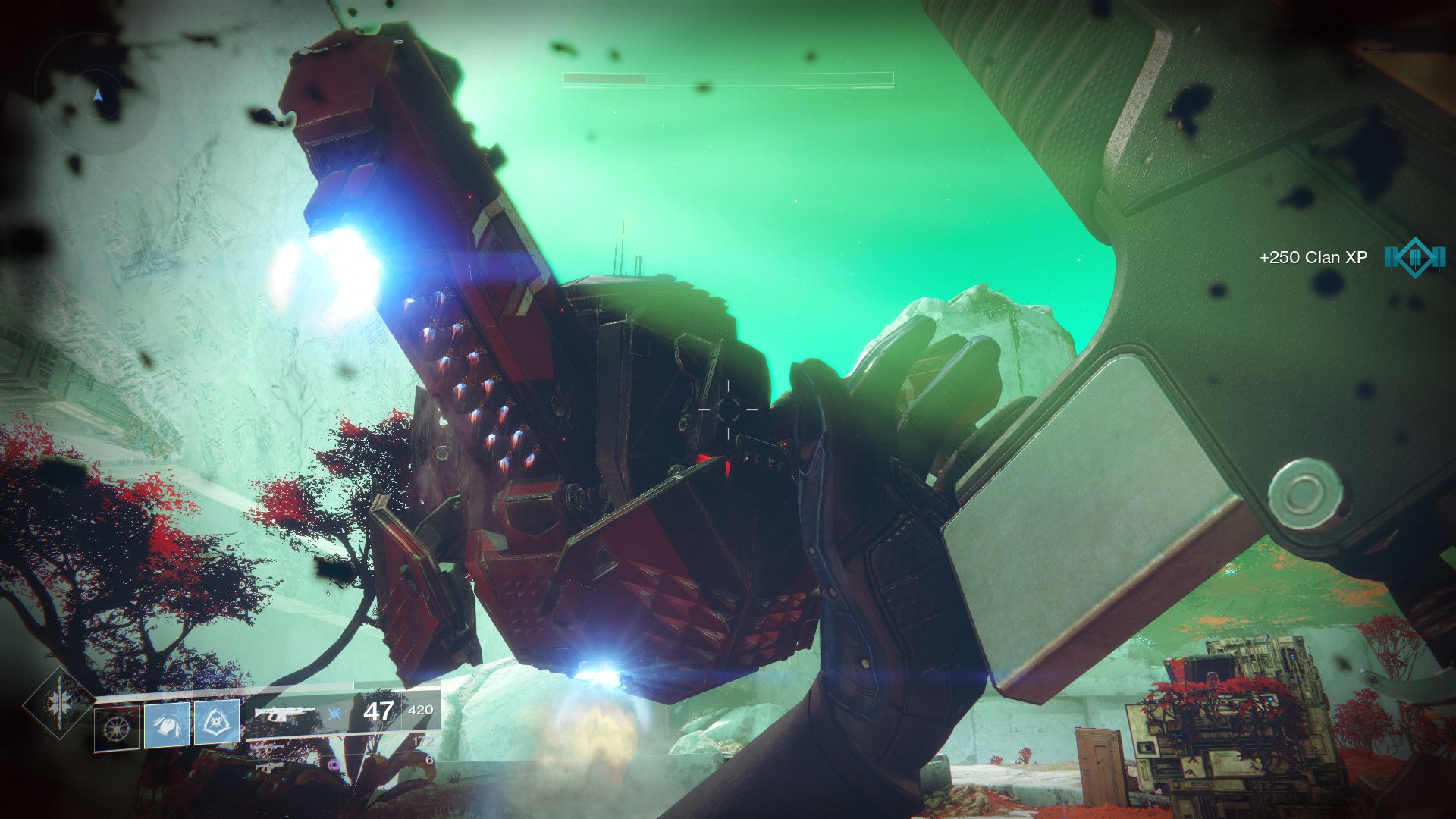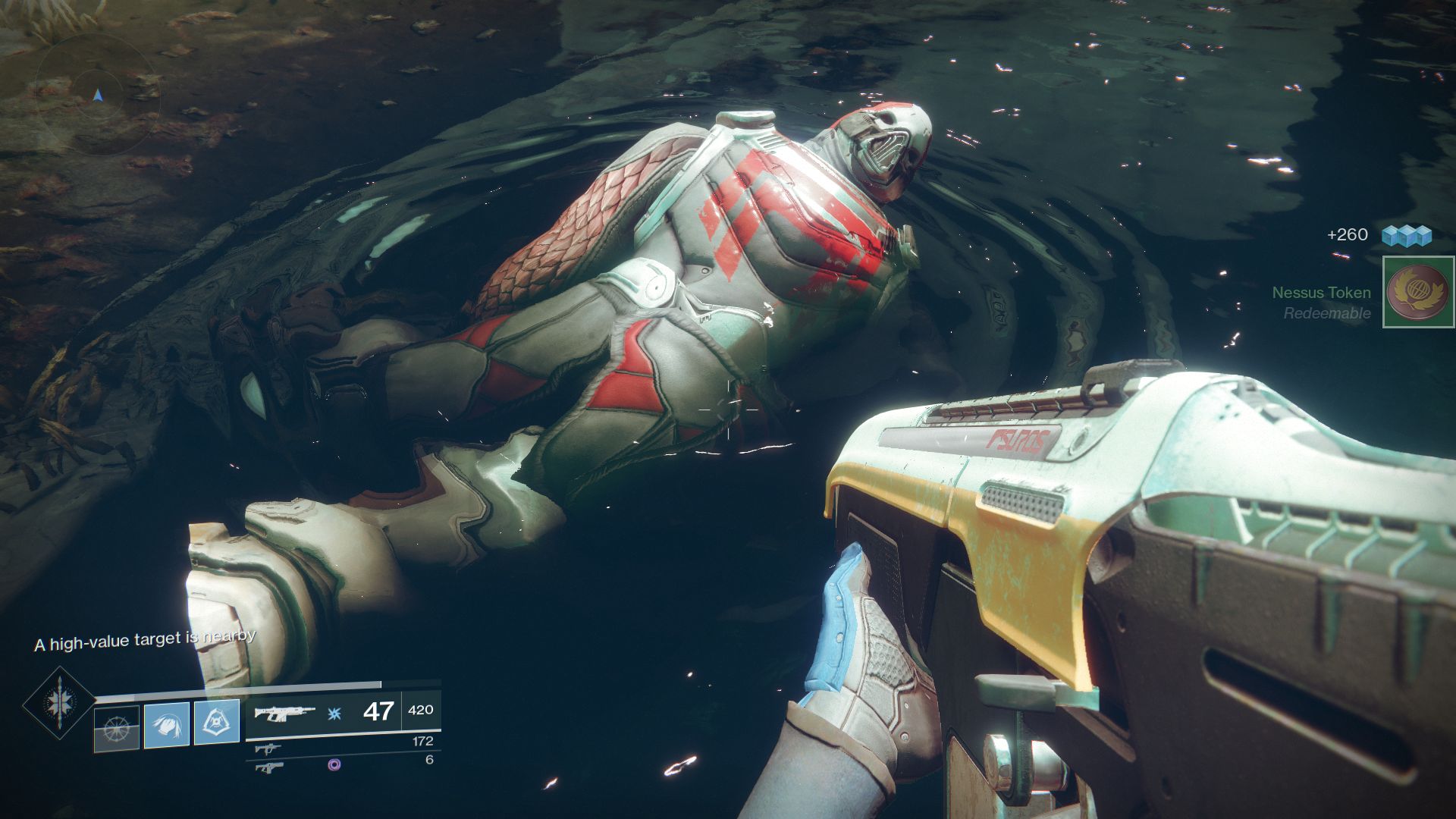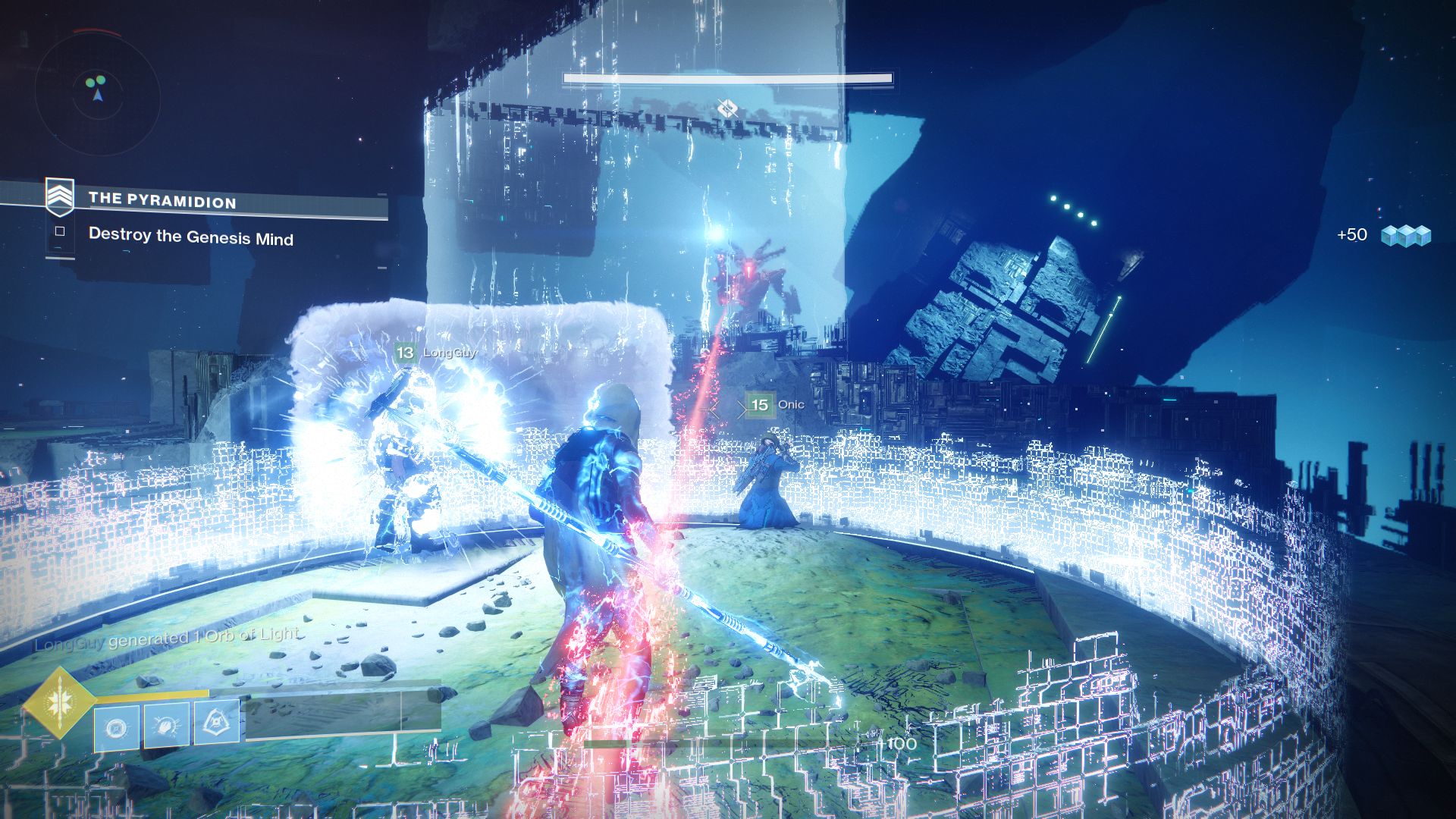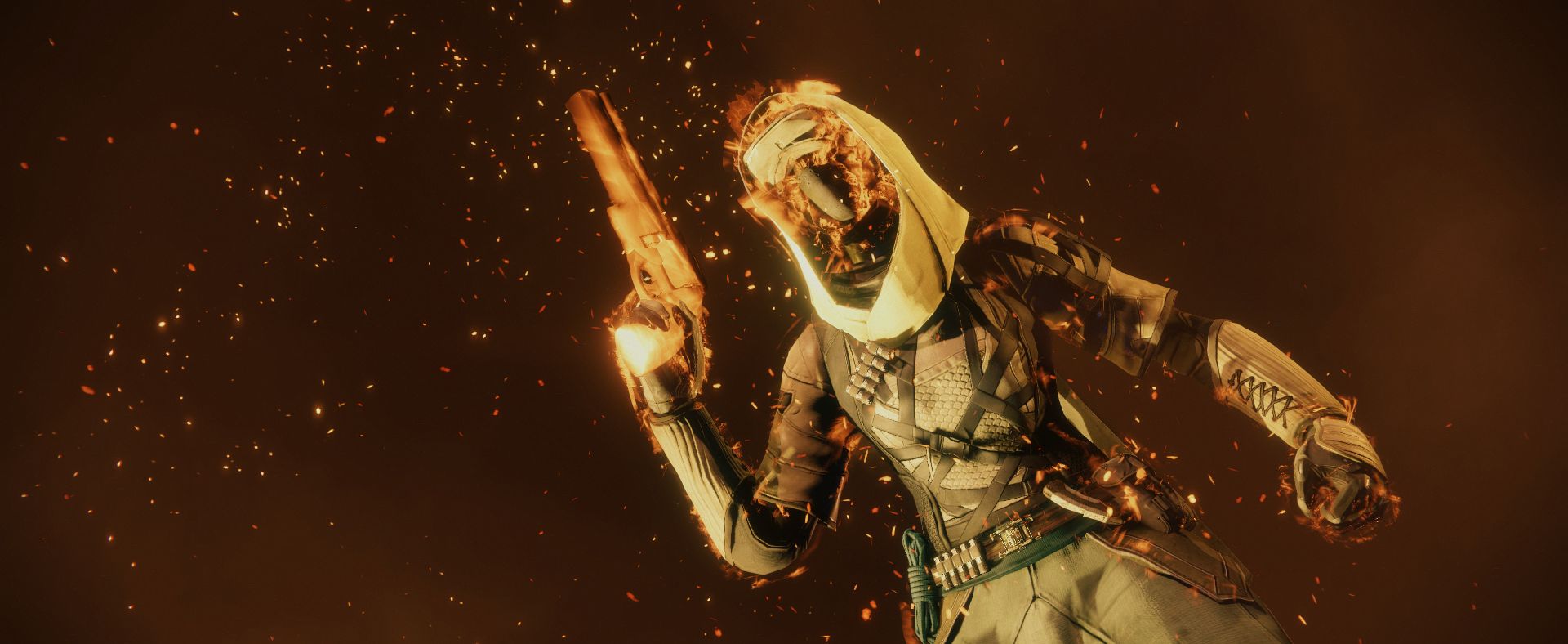Our Verdict
Gorgeous guns, a glittering universe, and a great port. Destiny 2 is an endgame away from true excellence.
PC Gamer's got your back
What is it? An online shooter set in a glittering futuristic vision of our solar system.
Expect to pay: $60 / £50
Developer: Bungie
Publisher: Activision
Reviewed on: GTX 970, Intel Core i5-2500K 3.3GHZ, 16GB
Link: Official site
Welcome to the era of the lifestyle game, where products are conceived, crafted and sold as persistent experiences intended to become a cornerstone of your leisure time. The brute force RPG treadmills of the monolithic noughties MMOs have given way to snackable games that use levels, loot boxes, card packs and incremental uneven rewards to entice us into putting in a few hours every week until the next game or expansion comes out. Destiny 2 is your next lifestyle game, but not because its progression systems are more enticing, or because its loot is particularly fabulous, but because it is a world-class shooter and a chill time with friends.
Destiny 2 is a persistent online FPS set in our solar system in the distant future. Four alien factions have converged on Earth to seize the power of a vast orb called the Traveler, which acts as humanity's silent protector. The Traveler's tiny drones, known as Ghosts, resurrect humans to serve as immortal Guardians charged with defending the planet. There are three flavours of Guardian to choose from. Warlocks can zap enemies with lightning, Emperor Palpatine style; Titans throw down shield walls and punch bad guys really hard; Hunters shank foes while dodge-rolling and tethering hordes with shots from a bow made of glittering purple energy. You pick your class, design your character, and get levelling.
It's a game of three phases. The singleplayer story gets you to level 20 and introduces the universe map, which you'll use for the next hundred or so hours to fly between planets to explore their open world zones, take on three-player Strikes (dungeons, to you and me), fight other players in 4v4 Crucible contests, and eventually take on the six-player raid. As you move through the story Destiny 2 starts laying the groundwork for phase two, beyond level 20, when you start hunting for weapons and armour to grow your new power level from 100 up to 305. This means repeating strikes, taking on public events in open world zones and doing short missions called adventures that extend the story on each planet. Phase three kicks in when you're close to the power level cap. At this point most activities in the game drop worthless lower level rewards and the game sputters out. You can expect 30 or so hours of quality shooting before you hit Destiny 2's doldrums. I think the journey is worth it.

Destiny 2's plot is simple. A warlord called Ghaul leads the lumbering rhino-people called the Cabal in an attack on Earth. He wants to siphon off the Traveller's power for himself, and you have to stop him across five or six hours of missions scattered across Earth, Titan, Nessus and IO. As the old Arthur C. Clarke saying goes, any sufficiently advanced technology is indistinguishable from magic. Destiny's fiction lives in this blurred area. Guns housing advanced AI fire ammunition that breaks apart reality. You might find wearing a far-future astronaut suit, or a helmet made from the bones of an extinct race of space dragons. Destiny's universe works better when you consider it as an anthology of these cool sci-fi ideas rather than a linear story. The Cabal are the main threat in this game, but every faction can bring their bespoke on-brand apocalypse scenario to bear whenever Bungie releases an expansion. The zombie-like Hive wants to consume everything to feed the symbiotic worm creatures that infest them. The cybernetic Vex want to resolve the ambiguities of the universe into a perfect network, which involves wiping out species that inconvenience them.
With practice you find yourself switching between weapons on the fly to take care of specific threats, chucking grenades into mobs, punching charging enemies into a million crackling pieces and repositioning with a jet-powered jump.
They all die beautifully, and the vast majority of your interactions with Destiny's curious universe happen at end of a gun. I get a rare feeling of satisfaction from taking a headshot in Destiny 2, and there is a deeply rewarding rhythm to combat encounters. Whichever class you choose you have access to a grenade and a melee attack, which recharge on cooldowns after each use. You have a loadout of three weapons to-hand (though it's easy to duck into the menu to swap these out if you wish). Kinetic weapons deal standard damage; energy weapons carry elemental charge that you use to shatter shields; heavy weapons are your big hitters, and include shotguns, sniper rifles, rocket launchers and even swords. With practice you find yourself switching between weapons on the fly to take care of specific threats, chucking grenades into mobs, punching charging enemies into a million crackling pieces and repositioning with a jet-powered jump. If enemies are massing, a tough boss turns up, or you've just had enough, you can activate your super power. Hunters can break out the bow, one-shot enemies with a flaming gun, or dice up mobs with an electric staff depending on the subclass you have equipped—warlocks and titans have their own variants.
After hundreds of hours of Destiny 1 and many hours of Destiny 2, it still feels great to dismantle a mob like this, and Bungie's shooter expertise translates surprisingly well onto PC. Mouse and keyboard controls, combined with a stable 60 fps of performance, adds an extra sense of control and fluidity. My experience with the PC version has been excellent. Destiny 2 has extensive settings menus that let you gear the game to your rig. It feels great to broaden out the field of view and absorb more of the game's gorgeous space vistas. Some of the default key bindings are off for me, but these too can be extensively rearranged to fit your setup.


Destiny 2 has a loot box system that lets you use real money and scarce in-game currency to buy cosmetic items from the 'Eververse' store.
Your level caps out at 20, but you continue to earn XP and fill your levelling bar past this point. Each time your levelling bar fills up you get a 'bright' engram that decodes into a package of premium cosmetic materials. These can be ships that you show off on loading screens, new skins for exotic guns, emotes, and shaders that change the colour of your gear.
You can also buy XP boosters that apply to you and your fireteam, however this simply accelerates the rate at which you're getting bright engrams for filling the levelling bar after 20. Shaders drop so often in the main game that I have never even considered buying a package with real money. It's an unintrusive and easily ignored loot box system, and you get regular drops from the premium pool as you play.
Destiny 2's first 20 hours are exhilarating. You see new planets, each of which benefits from some extraordinary art direction. Titan's missions take place on an industrial complex on stilts, which sustains a vast golden age arcology overrun by the Hive's corruption. The zone flows from man-made superstructures into defunct futuristic museum. The range of visual ideas in this one place alone would be enough to sustain a game by itself. Inevitably the splendour of the universe fades as you start blasting through zones to find a public event and try to secure some 280 power trousers, but there are few sci-fi games on PC that match Bungie's vision. The raid, when it arrives a week or so after launch, takes place in an opulent golden space palace.
It's a spectacular place to be, especially with friends. Destiny 2's positive multiplayer environment is as vital to the game's success as its weapon and encounter design. There is no public chat. Instead you opt in to communication, via voice or text, with your team mates in PvP, or your co-op fireteam. If you set the option in the menus, you can choose to receive whispers from strangers, but otherwise your communication with strangers is limited to comedy emotes. Agile menus let you seamlessly glide into co-op fireteams. Few games let you segue in and out of co-op so easily, and Destiny's imposed silence leaves no room for shitty behaviour.
Destiny 2 is a limited game if you play purely solo, but it is almost impossible to do that. Singleplayer missions move in and out of public spaces, and the game seems especially likely to trigger public events in these moments. These impromptu free-for-all missions often see an alien faction drop an objective into the world—a mining drone, perhaps, or a scanner—which you then have to defend against waves of incoming enemies. Everyone who runs into the area joins the event and becomes part of a ragtag assembly of fellow Guardians blasting hundreds of enemies for the promise of a treasure chest. Destiny is designed to let you flow organically through the gamut of activities, teaming up with friends and strangers as you go. Each play session is consists of a selection of public events, adventures, lost sectors (very short dungeons in public zones featuring a boss and chest), the odd Strike, and PvP.
The PvP Crucible is divided into two playlists called 'quick play' and 'competitive', and each consists of a selection of rotating modes. All of the bouts are four-on-four contests. All level differences are removed, but everyone is free to bring any guns from their armoury into the fight. A quick play match will randomly throw you into a team deathmatch scenario, a control point capture mode or supremacy mode, which is the best of the three. In supremacy every player drops a glowing crystalline 'engram' when they die. You pick up enemy crystals to score points, and secure friendly ones to deny your opponents. Supremacy creates an exciting tension between long and short-range weapons—picking someone off with a sniper is useless if you can't pick up their engram, but might be the right move if allies are closer to the kill zone. Expect lots of baseball slides to secure engrams under fire, and look out for Guardians rampaging with swords.


The game runs at a solid 60+ fps at 1080p on a GTX 970 with settings on ultra. There is a wide range of settings that give you control over your window mode, resolutions, Vsync, field of view, screen bounds, brightness, anti-aliasing, SSAO, texture anisotropy, texture quality, shadow quality, shadow quality, depth of field, environmental details, character detail distance, foliage shadows distance, light shafts, motion blur, wind impulse, HDR, chromatic aberration, and film grain. There are extensive key rebinding options too.
Performance faltered for me when I moved onto a 4K monitor. At this level you will need a top graphics card and to move some settings down to get a decent framarate. The anti-aliasing solutions aren't amazing but if you have a top card on a 1080p display consider upping the render resolution. It costs a lot of frames, but smooths out Destiny 2's jaggies.
Read our full performance analysis from the beta for more.
Competitive mode is split between a Counter-Strike style attacker vs. defender bomb defusal mode, and the brilliant survival mode. This gives each team a pool of eight lives, shared between players. It's team deathmatch with extra reason to be cautious. Tension escalates as both teams go low, and rounds can often end with a clutch play in a one-on-one showdown. Both of these modes also feature in the elite Trials of the Nine challenge, which is scheduled to arrive at weekends from November onwards. Here the most skilled Guardians with the best PvP gear battle for access to a special vendor who sells her own set of elite items.
Destiny PvP is unconventional by PC shooter standards. Positioning and skillful reading of the radar are essential skills. The best teams sit on comms and carefully manage their supers and loadouts to maximise their killing efficiency (letting off a super generates power orbs that pals can collect to charge more supers). Twitch skill is certainly a bonus, but mobile objectives, small teams and smartly designed maps strongly discourage camping and lone snipers. It's a fun drop-in experience that serves as a consistently entertaining diversion, though if you are mainly interested in strong player vs. player team shooter, you are better off with any of the big dedicated arena shooters.
Co-op Strikes are another important feature, but it's telling that they feel so superfluous at the moment. There are five, but they are only accessible via a random playlist that often forces you into. Strikes are full missions set in specially built areas. They normally consist of a series of combat encounters that culminate in a big boss fight, but feature some neat twists, like the Inverted Spire's quarry of giant whirling blades that comically splat your fireteam. Bosses tend to be huge, tough enemies that cycle through several phases as you deplete their health bar. One hides behind energy shields and snipes you, and you have to defend glowing pressure plates to pierce his defences. They are decent missions, especially when you start taking on their weekly nightfall variants, which introduce time limits, extra elemental damage and other modifiers to increase the challenge. However, Destiny 2's loot systems offer little incentive. The rewards feel slim for the time investment compared to public events.
More of these problems emerge as you move towards the end of Destiny 2's levelling curve, and the game settles into a holding pattern. Bungie launches semi-regular week-long events to give you the chance to come back and earn some new gear. In Iron Banner the gravel-voiced hero Saladin invites you to fight in the crucible for his favour. Week-long Faction Rallies also ask you to pledge allegiance to a faction and fight in their name in any Destiny 2 activities with the hope of beating the other factions and earning their special gun. It's a neat idea, and the comings and goings of Trials of the Nine and the weekend vendor Xur, make Destiny 2 feel like a living game. The problem is that after a while most items, especially armour, start to feel like purely cosmetic upgrades.

Exotics are the most valuable drops in the game. You can only hold one exotic weapon and wear one piece of exotic armour at a time, and they even come with a few paragraphs of prose that teaches you a bit more about Destiny's dense but fascinating lore. However the four warlock exotic helmets I have all offer inscrutable ability recharge buffs that don't feel as though they change my character at all. The same issue applies to the entire mod system, which lets you slot small upgrades into armour to grow your overall power level and gain minor buffs that might let you reload energy weapons a little faster, or grant you more resilience. As long as your power level is on point, the type of gear you wear barely matters.
Weapons are more interesting, especially when they are tuned to specialise in certain situations. Risk Runner become electrically charged when you take electricity damage, for example, so it's particularly good against enemies like the Fallen, who routinely carry electric weapons. Items like this have character and utility that makes them desirable, and Destiny 2 could use more of these at the top level of the game to give Destiny 2's most determined players something to chase.
The layers of level values, stats and damage numbers in Destiny can give the wrong impression. Destiny 2 is fundamentally a great shooter slotted into a lightweight levelling structure. Don't expect much in the way of RPG-style character building with skill trees and strong character builds. The three stats that govern your character's speed, resilience and recovery values have a minor effect on moment-to-moment play, but it's not worth worrying much about, and the simplistically organised subclasses leave little room for character customisation. My warlock feels like any other warlock in the game.
It's a shame that Destiny 2 runs out of gas in its final stages, but there's a chance that the DLC drops and the promise of reorganised reward structures will make Destiny's multitude of activities relevant again in the endgame. When the supply of spectacular new locations, new bad guys and new guns runs out it's remarkable how those extraneous progression systems—the ladder of incremental damage value upgrades, grinding for drops—becomes the entire focus of the game. I suspect Bungie see the loot system as the means, rather than the end, a way to draw players back together to enjoy social experiences. It comes back to the lifestyle game you want. If you're after an infinite action RPG then Destiny 2 is a few DLC packs and expansions away from that, but if you're after a regular light dose of beautiful sci-fi shooter fun, the perfect post-pub co-op jolly, or the game that will have your fireteam shouting in joy at your monitors when a raid boss goes down, Destiny 2 is a very well-made shooter and one of the best co-op games on PC.
Gorgeous guns, a glittering universe, and a great port. Destiny 2 is an endgame away from true excellence.
Part of the UK team, Tom was with PC Gamer at the very beginning of the website's launch—first as a news writer, and then as online editor until his departure in 2020. His specialties are strategy games, action RPGs, hack ‘n slash games, digital card games… basically anything that he can fit on a hard drive. His final boss form is Deckard Cain.



